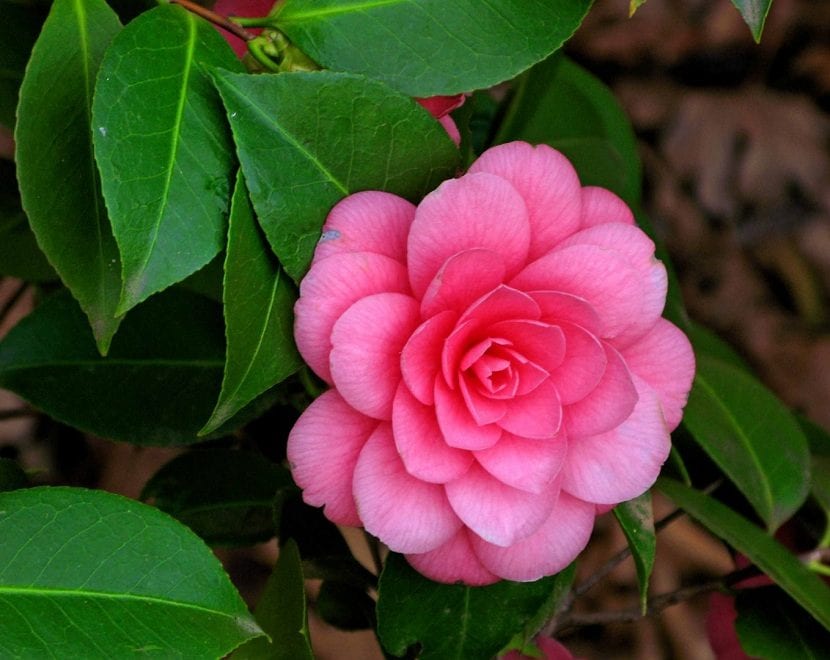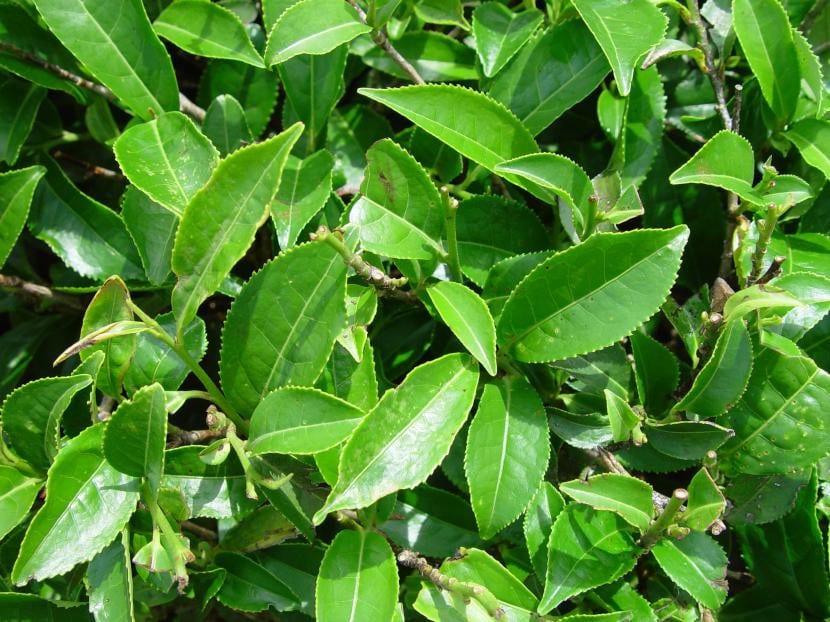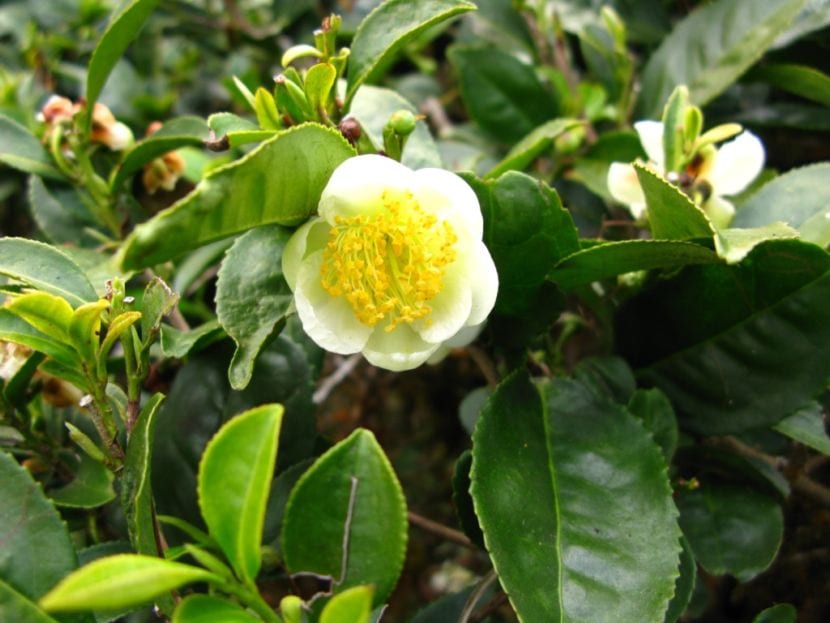
La camellia it is probably one of the most cultivated Asian shrubs in the world. Its beautiful flowers are so decorative that it is impossible to ignore them. In addition, they have other uses that you will discover in this special.
So if you want to know how do you take care of this plant, whether it is in a pot or in the garden, don't stop reading 🙂.
Origin and characteristics

Our protagonist is an evergreen shrub or tree native to Southeast Asia, specifically from China and Japan. It belongs to the botanical genus Camellia, which is made up of between 100 and 250 species, the best known being the Camellia japonica that you can see in the image above, or the Camellia sinensis which is the one with which the tea is obtained.
It can reach between 1 and 10 meters in height, one of the largest being the Camellia crapnelliana, which reaches 7 meters. Its leaves are leathery, whole, pointed, with the entire or slightly serrated edge, of a glossy dark green color.
It blooms in spring. The flowers are generally large, formed by five sepals and five petals, which can be double or multiple, white, red, pink or yellow. The fruit is a globose capsule that ripens in autumn.
What are the cares?
If you want to have one or more copies, then we are going to give you a care guide so you can enjoy your camellia during years:
Location
It has to be put in the Exterior, in semi-shadow. Ideally, you should give them indirect sunlight, as they do not grow well in shady places.
Soil or substrate
It is important that, regardless of whether it is in a pot or in the garden, the soil is acidic with a pH of 4 to 6, with good drainage. In calcareous lands its leaves turn yellow soon due to the lack of nutrients, mainly iron and manganese.
Although you can lower the pH by watering with water with lemon (½ lemon diluted in 1l of water) and making fertilizing with fertilizers for acidic plants (like this one from here), it is better not to risk it and plant it in those lands that are suitable for it from the first moment.
Irrigation
Must be frecuente, especially during the summer. Of course, we must avoid extremes: he does not like to have dry "feet", but neither are they waterlogged. To know when to water, simply insert a thin wooden stick (if it comes out clean, we can water since the soil will be dry), use a digital moisture meter or weigh the pot once watered and again after a few days (this difference in weight can serve as a guide to know when to water).
You have to use rainwater, without lime or water with lemon (mix the liquid of half a lemon in 1 liter of water).
Subscriber
In spring and summer It must be paid with a fertilizer for acid plants, following the indications specified on the package. It can also be paid in autumn if you live in an area with a mild climate, with light frosts.
Planting or transplanting time
In spring, when the risk of frost has passed.
Pruning
If required, overgrown stems can be trimmed in autumn, as well as the withered flowers.
Pests

It can be attacked by:
-
Trips: they are insects similar to earwigs but with a size of 1cm. They adhere to the underside of the leaves, from where they feed. They can be seen with the naked eye, both them and their droppings (they are like black dots).
To eliminate them, the leaves can be cleaned with a wipe or ear swab moistened with lime-free water, or by treating the affected specimens with Chlorpyrifos. -
Red spider: these mites also adhere to the underside of the leaves. They can be seen with a magnifying glass. You can tell if they have if we see cobwebs.
To eliminate them, they can be treated with neem oil or cleaning the leaves with lime-free water. - Mealybugs: they can be cottony or limpet type (with a brown shield). They adhere to the leaves and stems, from where they feed.
To remove them, the affected parts can be cleaned with a cloth or a small brush soaked in water and a few drops of pharmacy alcohol. - Aphids: they are parasites that measure 0,5cm and are brown, green or yellow. They adhere to the tender parts of the camellia and the flower buds.
To eliminate them, they can be treated with neem oil.
Management
- Mushrooms: they can cause the appearance of grayish powder (botrytis or powdery mildew), or rotting of the roots (Phytopthora is usually responsible).
We must control the risks and do preventive / curative treatments in spring and autumn with sulfur or copper. During the summer they will be treated with spray fungicides. - Chlorosis: it is usually due to the lack of manganese or iron, or due to excessive watering.
Provide these minerals and / or reduce the frequency of irrigation as the case may be. - Virus: are diseases caused by viruses that cause the appearance of mosaics on the leaves.
You have to cut the affected parts. - Bark cankers: produced by Glomerella or Phomopsis fungi.
You have to cut and burn the affected branches; in the case that it is in the trunk, it can be sanitized with a previously sharpened razor and disinfected with pharmacy alcohol.
Multiplication

Azaleas multiply by seeds, cuttings, and layering. Let us know how to proceed in each case:
Seeds
The seeds they have to be sown in a seedbed in spring, using a substrate for acidic plants (you can buy it here) or vermiculite. They must be placed on the surface, leaving a distance of 1-2cm between them, and keep the substrate moist.
Will germinate out of 1-2 months.
Cuttings
To obtain new azaleas that are identical to the mother plant branches of at least 30cm in length should be cut in spring. Then the base is impregnated with rooting hormones and planted in pots with porous substrates, such as kanuma.
Keeping it moist will root after about 2 months.
Layered
If we want to layer it, we must do it in spring, making a 1-2cm ring or ring without bark. This ring has to be infused with rooting hormones, since it is where the new roots will come out.
Next, a black plastic bag is taken and tied at one end and then filled with substrate for acidic plants, and finally be tied to the mother plant at the other end.
With a syringe, you have to keep the soil moist. A) Yes, will root after 2-3 months. When that happens, we can cut our new plant and plant it in a pot or in the garden.
Rusticity
The azalea supports frosts of up to -15ºC.
How do you care for camellia bonsai?
If what you want is a camellia bonsai that is beautiful all year round, follow our advice:
-
Location: outside, in semi-shade.
-
Irrigation: frequent, preventing the substrate from drying out completely. Use lime-free water.
-
Substratum:kanuma.
-
Styles: indifferent. Fits well with allAlthough it is especially pretty when styled in a formal or cascading upright style.
-
Subscriber: in spring and summer it must be paid with bonsai fertilizer, following the instructions specified on the packaging.
-
Pruning: only if you are healthy. Branches that have grown excessively in early fall, and wilted flowers, should be trimmed. Formation pruning should be done in late winter.
-
Transplant: every 2 or 3 years in spring, after flowering.
-
Wiring: in spring and summer.
Here is a video where it is explained -in English, I have not found it subtitled- step by step how to form a bonsai from a seedling:
What uses does it have?
Ornamental
It is a plant with a high ornamental value. In those gardens where the soil is acidic or slightly acidic, you can have beautiful low or medium-height hedges or as an isolated specimen. In addition, it can live well in a pot, so decorating a balcony or terrace with it will not be difficult at all if it has shade 🙂.
Medicinal

The species Camellia sinensis It has very interesting medicinal properties which are:
- Anti-allergy
- Antiasthmatics
- Antioxidants
- Antiseptics
- Bronchodilators
- Diuretics
The way to use it is drying the leaves and later crushing them to prepare tea. You can also use the flowers, or obtain oil from the seeds.
What is its meaning?
To finish, we reveal what its meaning is depending on the color of the flower:
- Blanco: represents innocent love.
- Red: it is the symbol of passion, desire and unconditional love.
- Pink: it is the color of seduction and the desire to be with the person you love.
What did you think of the camellia? You have someone?